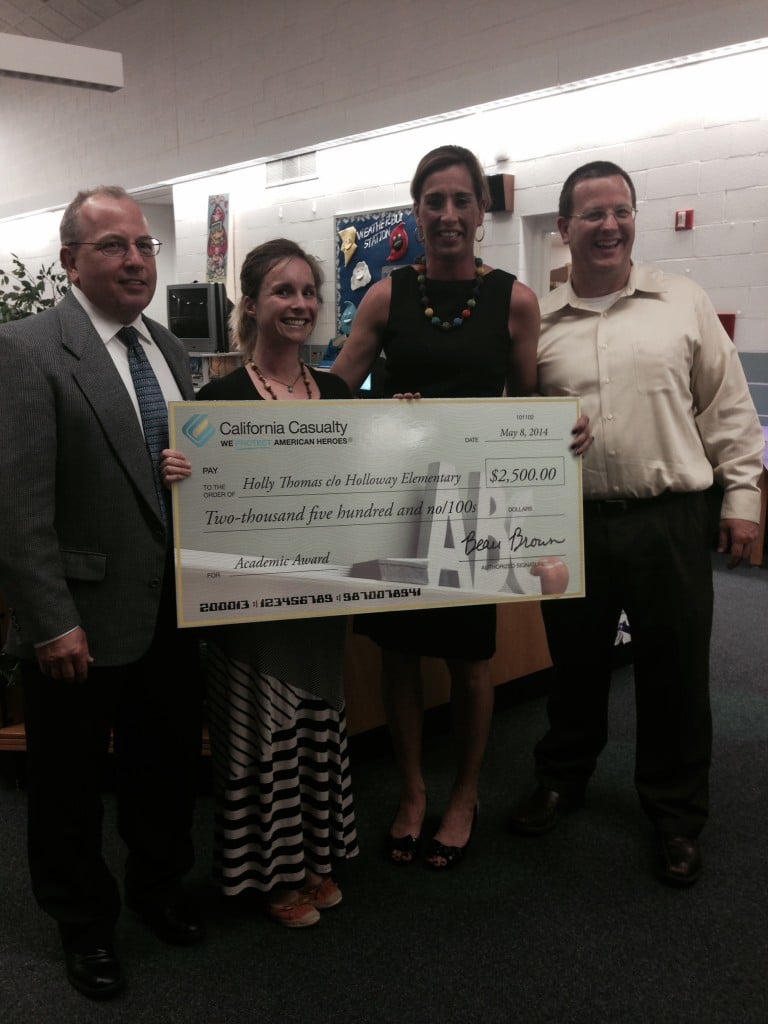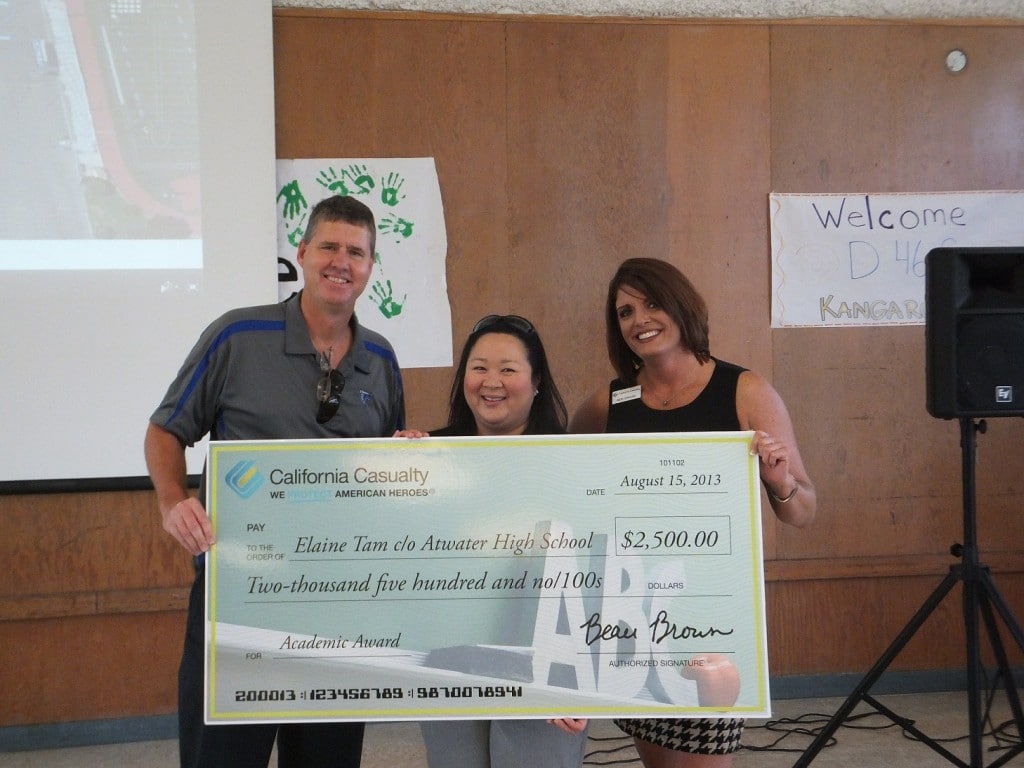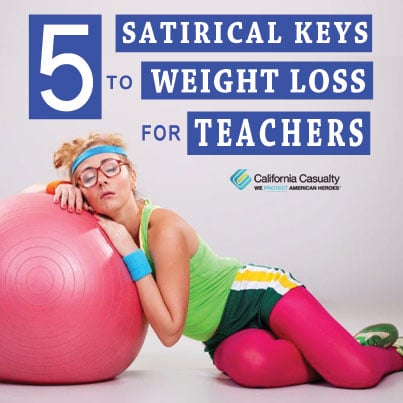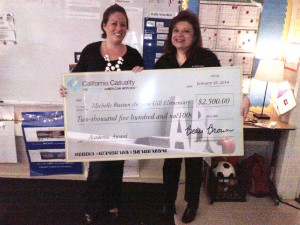by California Casualty | Educators |
$2,500 can go a long way, especially for educators. It’s no secret that teachers spend out-of-pocket money for their students; what might surprise many is how much. A recent study from the National School Supply and Equipment Association found 99 percent of instructors used an average of $500 of their own money to equip their classrooms. However, many educators report putting out much more than that for school necessities, with the amounts closer to $1,000 to $2,000 each year.
There are many great resources to help classroom instructors stretch their budget for classroom supplies. Edutopia compiled grassroots tips and links from educators around the nation on getting free supplies and organizations that help teachers get the goods they need. They include:
Another is the California Casualty $2,500 Academic Award.
Ohio kindergarten teacher Holly Thomas is the most recent recipient. Holly says she routinely spends between $1,000 and $1,500 per year on her classroom and students. The grant has enabled her to buy bins and containers for the 500 children’s books and other materials she has accumulated in her 6 years as a teacher. She is also using her California Casualty Academic Award to augment the science center she has created in her classroom and will use some of the funds to build six garden boxes for her students to plant and enjoy. Holly is teaming up with the nonprofit ToledoGrows for the project.

Holly, who is paying off student loans and covering tuition for her Master’s degree in Instruction and Curriculum, says having extra resources to purchase classroom needs as they arise has taken a lot of pressure off her finances and added to her well-being.
“We are repeatedly told we have to do more with less. With what we are expected to accomplish, with the resources available and the demands being put on us; my job is becoming more and more stressful. I try very hard to remind myself daily that I am molding the lives of five and six year olds”
Holly, urges instructors to take advantage of grant programs like the California Casualty Academic Award. She can now fund new ideas to help inspire her students. “It feels good to be supported by such amazing organizations as the NEA and California Casualty,” she said.

Elaine Tam was the recipient of the California Casualty Academic Award in August 2013. Elaine is a California high school teacher who applied the grant towards a trip to the Monterey Bay Aquarium. Forty eight students were able to tour the aquarium and enjoy the beautiful coastline in the area; many of them had never been to the ocean before. Elaine said, “As always, recognizing educators isn’t done nearly enough in society so this award is undoubtedly welcome.” She too urges educators to take a moment and apply.
Whether your need is for new technology, electronic tablets or traditional supplies of books, snacks, pencils and paper, do what Elaine and Holly did and let California Casualty pick up the tab with the $2,500 Academic Award. There are restrictions and official rules and the application can be found at www.calcasacademicaward.com.
Resources for this article:
https://blogs.edweek.org/
https://teacherscount.org/teacher/grants.shtml
https://www.edutopia.org/free-school-supplies-fundraising-donation
https://www.k12grants4teachers.com/
by California Casualty | Educators |

We understand that the day-to-day life of a teacher can be more difficult than many imagine. Hopefully, this humorous take on health and fitness for teachers will brighten your day!
It’s not easy to be a dedicated teacher and keep off those unwanted pounds. Here are 5 (satirical) tips on health and fitness for the busy educator!
1. Consume fewer calories than you burn:
Skip breakfast – this one should be pretty easy right? You have to get up at 5 a.m. and out the door at 5:30, so breakfast is usually just a longing glance at the fridge as you rush out. You can’t be late for the student’s arrival – plus, there are still papers to grade because you didn’t have them all finished at 11pm last night!
Since you have anywhere from 2-5 minutes for a leisurely lunch, you should try to stick with things that don’t need refrigeration and can be consumed through a straw.
Increased student/teacher ratios have undiscovered calorie-burning benefits! As you walk around to 30 or 40 desks to check progress and answer questions, think of the extra mileage you’re putting in!
2. Incorporate resistance training:
Resistance is part of the job! You regularly push back against those who aren’t focused on your students’ learning. You butt heads and lift up your students. You pretty much have resistance training down. Amplify the effect by trying to flex your abs during parent teacher conferences.
3. Try high intensity cardio:
You’re 50 yards from a bathroom, and you have 45 seconds before class starts. The full out sprint there and back should get your heart rate into the fat-burning zone! Try to repeat more than once a day.
4. Cut the carbs:
Refined carbohydrates and sugar cause your blood sugar to spike, leaving you groggy, unfocused, and grumpy. Why should you get to act like your students!?!? Instead, eat lots of veggies and be the only person in the room who isn’t napping.
5. Get plenty of rest.
Sleeping in isn’t an option, so the best you can do is get to bed early. As early as you can after staying late at school, caring for your family, grading papers, and fielding “emergency” parent emails……you know what? Forget it – just book a hotel room for the two weeks out of the summer you’re not working and try to sleep that entire time. Many hotel chains offer teacher discounts, and don’t forget to hang out the do-not-disturb sign!
**Bonus Tip!
Hydration is important. You get extra credit for this, as it really ramps up your high intensity sprints to the bathroom!
We hope these tips made you chuckle. At California Casualty, we appreciate how difficult it can be for teachers, which is why we created our Academic Award. You can win $2,500 for your classroom, just click here to enter.
by California Casualty | Educators |

The California Casualty Academic Award was created to help defray costs that educators pay for classrooms and other instructional materials. A recent survey found public school teachers spent $1.6 billion of their own money on classroom supplies and gear in the 2012-2013 school year, with each teacher averaging $500 of their personal money.
The latest California Casualty Academic Award winner is California teacher Michelle Ruxton, who received her Academic Award check Thursday, January 16, 2014. Her name was randomly selected from more than 15,000 entries from across the nation.
Ms. Ruxton is in her second year at John Gill Elementary School, in Redwood City, California, where she teaches 5th grade. She says she will use the money to invest in a Smart Board projection system to enhance the education experience of her students by integrating lessons with fun and engaging multi-sensory curriculum.
Ruxton says she has spent more money than she cares to admit on supplies for her students and classroom. “Thank you for the award! My class and I are ecstatic,” she said.
Previous Academic Award winner, Atwater, California, high school teacher Elaine Tam, is using her California Casualty Academic Award money to fund a bus trip to the Monterrey Bay Aquarium and for school room supplies. Heidi Fortney, kindergarten teacher in Sycamore, Ohio, bought iPads for her students to use.
“California Casualty, which has 63 years of ties to public education, wants to help educators in their tireless work to educate our children. This is just one small way we can say ‘thank you’ for the dedication and sacrifice made daily on the job”, said Vice President Mike McCormick.
Entries are now being taken for the next Academic Award contest, with the winner announced April, 2014. Eligibility requires membership in the AEA, CTA, NEA (National Education Association), or referred by a current member of the state NEA affiliate or one of our other participating educator associations including: ACSA, CASE, COSA, KASA, NASA, UAESP or UASSP. Complete rules and information can be found at www.calcasacademicaward.com.
by California Casualty | Educators |
CT Educators See Their $7,500 School Lounge Makeover© From California Casualty
The New Year will be brighter and more comfortable for the English Department at Plainville High School in Plainville, Connecticut, after a $7500 School Lounge Makeover© from California Casualty.
The contest was won by Debbie Seibert, who discovered it while reading her NEA Today publication. She was announced as the latest winner in November and the finished product was unveiled Friday, December 20. Teachers and staff were greeted by new vibrant colors; a stylish reading area with new furniture, area rug and accent chairs; a large metal table to accommodate a microwave, toaster oven and crock pots; a work space for a “floating instructor” who has no permanent classroom; and, what is thought to be a first for the School Lounge Makeover® contest, a lactation area. “It’s now a striking, soothing area,” remarked Seibert. “Thanks to California Casualty we now have an efficient, inviting work space and lounge, including cabinetry with storage that is built at work height. This replaces the collection of scavenged desks and tables that held our equipment before. …and our instructional leader has a new chair for her office so she no longer has to tighten the screws weekly to avoid it collapsing under her,” she said.


Recognizing the lifelong impact of teachers and the current financial strain on public schools, California Casualty created the School Lounge Makeover® contest in 2011. Twice a year, one randomly drawn winner receives a major transformation of the primary space at his or her school that teachers and staff can go to rejuvenate and recharge.
Entries for the next California Casualty $7,500 School Lounge Makeover® are now being taken here . A contestant must be an active employee of a K-12 public school or school administrator and a member of NEA or ACSA, COSA, NASA, KASE or OAESA. Should a school administrator win who does not work on a school campus, he/she will have the option of choosing the public school to receive the makeover. All members at the school may also enter, thus increasing their school’s chances of winning.
by California Casualty | Educators |
3 Amazing Back To School Classroom Games
A Guest Post By Melinda Crean https://topnotchteaching.com/
Key Words: classroom games, games to play in the classroom, back to school, back to school games
Do you want to learn some spectacular new classroom games that will ease those back to school classroom jitters?
It’s that time of year again when many of us fearless teachers are heading back for a new school year. It’s an exciting time for both the kids and the teachers, but it can also be a little scary and as a teacher you may feel somewhat apprehensive.
I’ve found that one way you can help ease those worries and nerves is to play regular classroom games with your students.
Playing games is a really great way for your students to get to know each other and learn about social behaviors. Games also assist in teaching a number of other important skills, such as:
- Playing fairly;
- Controlling body language;
- Getting along;
- Handling winning and losing;
- Taking risks;
- Co-operating with others; and
- Demonstrating self-control.
Games can also be quite strategic, which helps to develop mathematical thinking, planning ahead, predicting and hypothesizing.
I’ve found that by using games regularly in the classroom it helps to develop positive relationships between students and with the teacher. So without further ado…..here are my top 3 sensational back to school classroom games.
1. Wink Murder
Skill focus: controlling body language, co-operating with others, taking risks and good to use as a whole class reward.
You will need: A large open space (indoors) for the whole class to sit in a circle.
The game:
- This game can be played in small groups of 4 or more students, but I find it works best with the whole class.
- Get your students to sit in a large circle.
- Select one person to be the ‘guesser’. Send that person outside the room so that a ‘murderer’ can be selected.
- Select one student to be the ‘murderer’.
- The ‘guesser’ comes back to the room and sits/stands in the middle of the circle.
- The murderer tries to kill all the other players in the circle by winking at them without being observed by the ‘guesser’.
- If a player is winked at, then they must wait 10 seconds and then fall down dead.
- The ‘guesser’ can say the name of a student if they think they’re the ‘murderer’.
- The game ends when all the players have been murdered and only the ‘murderer’ remains, or if the ‘guesser’ correctly identifies the ‘murderer.’
- Continue the game by selecting a new ‘murderer’ and ‘guesser’.
2. Order In The Court
Skill focus: co-operating with others and demonstrating self-control.
You will need: A large open space (indoors) for the whole class to sit in a circle.
The game:
- Get your students to sit in a large circle.
- Students say the below rhyme altogether while tapping their fists on their thighs to keep the beat.
Order in the court
The judge is eating beans
His wife is in the bathtub
Counting submarines
- The teacher or a selected student then needs to offer a challenge to another student. For example, after the rhyme is said, the students still keep tapping their thighs and the teacher will say “5 boy’s names”, the students’ then copy the teacher “5 boys’ names”. When the students have copied, the teacher will say a student’s name “Jane”, the students then copy the teacher, “Jane”.
- Then Jane needs to say 5 boys’ names. After each name she says, the whole class copies.
- If Jane misses a name or can’t think of any answers, then the challenge is passed to another student.
- If Jane is successful at the challenge then she can select the next student for the new challenge.
- The whole time students are still tapping their thighs with their fists to keep the beat.
- After the challenge is successful the students as a whole say the rhyme again. The teacher then selects a new challenge and a new student.
- Some example challenges could include: boys/girls names, towns near where you live, countries, colors, months in the year, types of cars etc.
- You can change how many you ask to be named to suit the age of your students.
3. Spoons
Skill focus: handling winning and losing, playing fairly and controlling body language.
You will need: 2 packs of cards for each group of students, spoons for each group of students (1 less spoon than the number of players in a group), space for students to sit in a small circle.
The game:
- This game is best played in small groups of students, between 4 – 8 players.
- Students sit in a circle.
- Place the spoons in a circle in the middle of the group. There should be one less spoon than players.
- One person is selected as the dealer. They shuffle the cards and have them face down in a pile next to them.
- The dealer gives each student one card from the pile. The student must remember what card they have and then keep the card face down in front of them so no other student can see what card they have.
- The dealer then takes one card at a time and looks at it. They are trying to find a card that matches the card they have face down in front of them. The card does not need to match suit, but must be of the same value. E.g. two queen’s, or two eight’s etc.
- When the dealer has looked at the card, and if it does not match their card, they then put it face down in front of the person next to them (clockwise) in the circle. That person then looks at the card and the card continues around the circle if it does not match.
- The dealer continues taking cards from the pile, looks at them and if they don’t match passes to the next player.
- If a player is given a card that matches the card face down in front of them, they add this card to the other card. They then take a spoon from the pile in the middle of the circle and add it with their cards. They try to do this quietly so they don’t notify the other students.
- If another student sees that a spoon has been taken, then they are able to take a spoon and add to their pile.
- The game keeps going with students trying to match cards until all the spoons have been taken from the middle.
- The person that does not have a spoon is the loser of the round.
- The game can start again for another round, with a new dealer.
- This game is lots of fun and can get very rowdy. It moves very quickly with lots of cards moving around the circle and spoons being taken and moved.
I hope you enjoyed learning some groovy new classroom games and have fun using them with your students. If you’re after some more game ideas then have a read of 6 Classroom Games You Can Use To Re-Energize Your Students. (https://topnotchteaching.com/time-saving-tips/classroom-games-to-re-energize/)
by California Casualty | Educators |
Remembering those who have given their all for their profession is the tribute that lasts forever.
Last Friday, I had the honor of attending the groundbreaking ceremony for the National Teachers Hall of Fame’s Memorial to Fallen Educators.
As I walked amongst the crowd at the groundbreaking, I kept hearing the word ‘bittersweet.’ And that’s exactly what it was. Bitter that such an occasion, that such a memorial, is even necessary. Bitter that teachers who dedicated their lives to improving the lives of their students died doing what they love- a job they probably never guessed would put their lives on the line. But there was sweetness there, too. Sweetness that they weren’t forgotten. Sweetness that all these people, people who had never met any of the victims, came out to pay their respects- some of them driving hours to see the symbolic groundbreaking.
Tragedies like Sandy Hook and Columbine bring worthy attention to the brave sacrifices of teachers on behalf of their students, but those teachers are not alone. American educators have been losing their lives in school tragedies since 1853. Every single one deserves to be remembered, to be honored, and to be recognized for their dedication and their bravery.
The actions of the six educators at Sandy Hook show us something about teachers as people. Talk to any educator and they will tell you that they too would do whatever it took-make any sacrifice- to shield their students from harm. For educators, their students aren’t just ‘students’ and teaching isn’t just a job. It’s bigger than that. For every educator I know, their students are their family and their job is a calling.
The Memorial to Fallen Educators is a way for all of us to honor every single teacher who lost their life at work. It also serves as a reminder of what every single teacher is willing to do for their students. It was truly an honor to stand amongst the crowd and witness this bittersweet moment in history.






